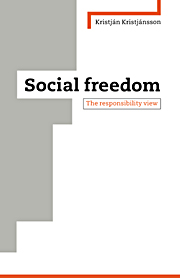Book contents
- Frontmatter
- Contents
- Acknowledgements
- 1 Introduction: freedom from Berlin onwards
- 2 Negative freedom: the nature of constraints
- 3 Obstacles and their weight
- 4 The test of moral responsibility
- 5 Internal bars and positive liberty
- 6 Freedom and power
- 7 Observations on method
- 8 Concluding remarks
- Bibliography
- Index
8 - Concluding remarks
Published online by Cambridge University Press: 31 March 2010
- Frontmatter
- Contents
- Acknowledgements
- 1 Introduction: freedom from Berlin onwards
- 2 Negative freedom: the nature of constraints
- 3 Obstacles and their weight
- 4 The test of moral responsibility
- 5 Internal bars and positive liberty
- 6 Freedom and power
- 7 Observations on method
- 8 Concluding remarks
- Bibliography
- Index
Summary
A distinguished philosopher once remarked that there could be no general theory of holes since holes are dug for different purposes: by children in the sand, by gardeners to plant lettuce, etc. My book should have brought to light that there can be no general theory of freedoms either. The most we may hope for is to clarify the concept of a specific kind of freedom by looking at the purpose it can most usefully be made to serve. Indeed, this has been my aim here, namely, to arrive at a definition of social freedom. In the case of that particular concept, people have often used the term ‘social freedom’ as a shopping trolley which could be packed with anybody's chosen selection of separate goods. By contrast, I have tried to show how an open-textured and normative, but yet authoritative, definition can be arrived at through naturalistic reasoning: a definition that catches the point which the term should reasonably be made to convey and is not unduly relativistic.
It would be lighting a candle to the sun to rehearse here the various arguments employed in the course of my discussion; – my polemic targets being as many as was deemed necessary to reach out to the perplexity of the issues at hand – these are to be found in the relevant chapters.
- Type
- Chapter
- Information
- Social FreedomThe Responsibility View, pp. 206 - 211Publisher: Cambridge University PressPrint publication year: 1996



